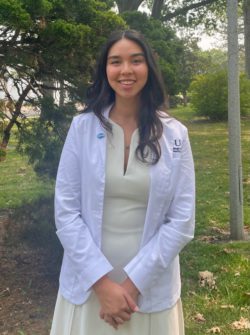Can Molokai’s Medical Future be Home Grown?
By Jack Kiyonaga, Reporter

Photo courtesy of Pono Castanera.
Most are familiar with the dire healthcare landscape on Molokai. With the passing of doctors Emmett Aluli and William Thomas in the past year, many Molokai residents were left without permanent primary care physicians. Help has come in the form of interim doctors flown over for relatively short periods. More long-term solutions have manifested in the recently opened Molokai Urgent and Family Care Clinic, operated by Dr. Ka‘ohimanu Dang Akiona with Aluli’s former staff. But the root of the problem remains unsolved: how to have more full-time, community-engaged doctors on Molokai.
Pono Castanera wants to be one piece of solving that puzzle.
Raised on Oahu, Castanera has family on the east end of Molokai and spent the summers here growing up. Now, he’s taking steps to make Molokai his home as a full-time doctor.
“Molokai is a second home to me,” said Castanera. This personal connection is paramount to what Castanera hopes to achieve as a doctor on Molokai.
“My dream is to work on Molokai,” he explained. “My end goal is to work here in a permanent position.”
Castanera is currently doing a one-month rotation at the Molokai Urgent and Family Care Clinic as well as Molokai General Hospital as part of his last year of medical residency. A graduate of the University of Washington, Castanera attended medical school at the John A Burns School of Medicine at the University of Hawaii.
A Lasting Inspiration
It was before his first year of medical school at the “white coat ceremony” that Castanera was introduced by his father to Dr. Aluli – it was an encounter that would change the course of the aspiring student’s career.
“[Aluli] was larger than life,” said Castanera. “I’m trying to make him proud.”
When Castanera ran into Aluli again at a talk at the University of Hawaii, Castanera inquired about working with him over the summer. Castanera ended up doing two one-month rotations at Aluli’s office over the next couple years.
The experience was “really cool and really eye opening,” explained Castanera.
With Aluli, Castanera was able observe what community engagement as a doctor could look like. What impressed Castanera most was how Aluli was able to “be an integrated part of the community…I don’t think anyone could fill his shoes.”
When Castanera returned to Molokai a couple years after his rotations with Aluli, he noticed how drastically the healthcare landscape had changed.
“The biggest need I see is just a lack of providers,” he explained, which leads to fewer regular appointments and more long-term health complications.
As a young doctor, Castanera had some thoughts on why Molokai has a hard time attracting new doctors.
“What makes it difficult to attract [permanent] physicians is, one, the lifestyle…people want different things, the mall, movies, stuff like that,” said Castanera.
Other factors also weigh on new doctors: “Will I be happy here…does it make sense for my family,” as well as cost of living, he explained.
Establishing Longevity
For healthcare on Molokai to function for everyone, “the reality is that we need physicians here that are willing to stay,” said Castanera. The best way to do this is to have local kids study medicine, he added.
“We need to have people from the community serving the community. Building physicians takes a community.”
Kim Svetin, president of Molokai Drugs, echoed this sentiment, explaining that “we have to groom our young people before they go to college. You have to have it planted to want to be a family physician on Molokai.”
For Svetin, some of the challenges of attracting doctors, even home-grown ones, can lay in the lack of diversity in choices for schools, transportation and housing.
“You need to have a partner or spouse who also wants to live here,” explained Svetin. “What we need to do to attract these doctors is have a great school system on Molokai.”
And while challenges remain in retaining doctors, some of Molokai’s own are pushing forward in careers in medicine with the full intention of returning to Molokai.
Homegrown Hope

Photo courtesy of Kamalei Davis.
Take, for example, Kamalei Davis.
“[Davis] is the exact example of what needs to happen,” said Svetin.
Davis, a graduate of Kualapuu Elementary School before heading to Kamehameha Schools, started her first year of medical school at U.T. Still University in Missouri this past Monday.
“It’s a long journey to embark on,” said Davis. “You always have to keep reminding yourself of why you’re doing this…for me, I always have to re-center myself that this is something that my community needs, and more so this is the way I can give back to the community that raised me.”
Speaking candidly about the potential challenges of becoming a doctor, Davis explained that while difficult, help was there when she needed it. After receiving a full scholarship to Chaminade University in Oahu, Davis was able to find another scholarship for Native Hawaiians that would cover her medical school costs.
Even before securing this medical school scholarship though, Davis was prepared to make the sacrifices necessary to become a doctor.
“It will be worth it in the end,” she said. “That’s what it is to be a doctor. It’s to sacrifice for the sake of others and to help others.”
While Davis is still seven years out from completing her schooling and residency, she remains committed to her path of returning to Molokai to practice.
“It just is going to take a lot of time…once I establish myself as a physician, that’s when I’ll be able to come back,” she said. “I can’t think of much that would stop me from coming back to Molokai.”











Don't have a Molokai Dispatch ID?
Sign up is easy. Sign up now
You must login to post a comment.
Lost Password